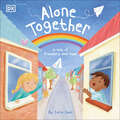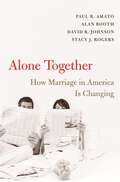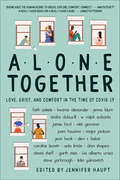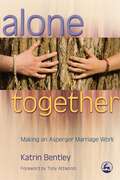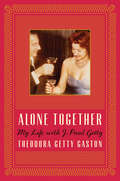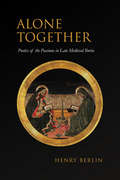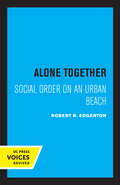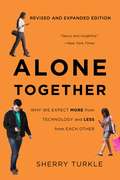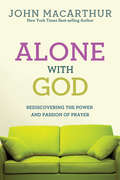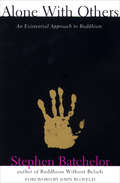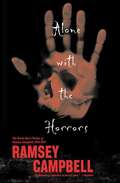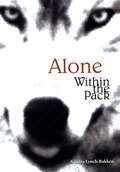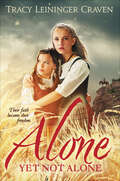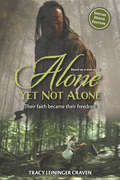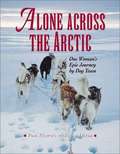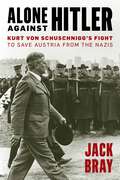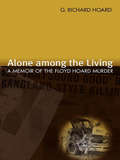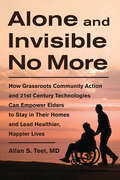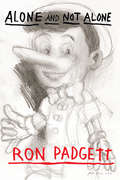- Table View
- List View
Alone Together Again: A Comedy
by Lawrence RomanIn the hilarious Broadway comedy, ALONE TOGETHER, Mom and Dad have spent the last thirty years raising three active sons. How they looked forward to the peace, the quiet and the privacy of an empty nest. After considerable comic turmoil and revelation of deep feelings, the nest is finally emptied. Peace now? Quiet? Not for long. The empty nest fills up again by the sudden, unexpected arrival of their parents, each with a problem which is dumped on Mom and Dad. How to empty the nest once again so Mom and Dad can be alone together. Cleverly comic, witty and wise. ALONE TOGETHER AGAIN has delighted audiences in Europe as well as the U.S.
Alone Together: A Curious Exploration of Loneliness (Orca Think #12)
by Petti FongThe world is facing an epidemic of loneliness. The COVID-19 pandemic taught us new words, like isolation, quarantine and social distancing. In places like the UK and Japan, governments have appointed ministers of loneliness to examine the problem and find ways to help their citizens. What does it mean to be lonely, and what can we do about it? Alone Together explores what superheroes can teach us about being alone, the ways kids have survived on their own and how activists in the civil rights movement took a stand against loneliness. Discover what comfort foods, sweatpants and being kind to each other have to do with loneliness. Based on the podcast of the same name. Readers will learn about loneliness and how being alone can ultimately bring us closer together. The epub edition of this title is fully accessible.
Alone Together: A Tale of Friendship and Hope (Understanding the Pandemic for Kids)
by Julia SealIt isn't a normal sort of a day. The sun is up, the birds are out, but everybody's indoors.Having to stay home can be confusing and lonely for children. This heart-warming story by author-illustrator Julia Seal highlights the importance of friendship and community during these challenging times. The beautiful illustrations and message of hope will help children see the power of togetherness, and understand that even though we might feel like we're alone, we're alone together.
Alone Together: How Marriage In America Is Changing
by Alan Booth David R. Johnson Paul R. Amato Stacy J. RogersMost observers agree that marriage in America has been changing. Some think it is in decline, that the growth of individualism has made it increasingly difficult to achieve satisfying and stable relationships. Others believe that changes, such as increasing gender equality, have made marriage a better arrangement for men as well as women. Based on two studies of marital quality in America twenty years apart, this book takes a middle view, showing that while the divorce rate has leveled off, spouses are spending less time together--people may be "bowling alone" these days, but married couples are also eating alone. Indeed, the declining social capital of married couples--including the fact that couples have fewer shared friends--combined with the general erosion of community ties in American society has had pervasive, negative effects on marital quality. At the same time, family income has increased, decision-making equality between husbands and wives is greater, marital conflict and violence have declined, and the norm of lifelong marriage enjoys greater support than ever. The authors conclude that marriage is an adaptable institution, and in accommodating the vast changes that have occurred in society over the recent past, it has become a less cohesive, yet less confining arrangement.
Alone Together: How Marriage in America Is Changing
by Alan Booth David R. Johnson Paul R. Amato Stacy J. RogersBased on two studies of marital quality in America twenty years apart, Alone Together shows that while the divorce rate has leveled off, spouses are spending less time together. The authors argue that marriage is an adaptable institution, and in accommodating the changes that have occurred in society, it has become a less cohesive, yet less confining arrangement.
Alone Together: Love, Grief, and Comfort in the Time of COVID-19
by Jennifer Haupt"Could there be a timelier gift to quarantined readers...? I doubt it."óThe Washington Post"A heartening gathering of writers joining forces for community support."óKirkus Reviews"Connects writers, readers, and booksellers in a wonderfully imaginative way. It's a really good book for a really good cause"óBestselling author James PattersonALONE TOGETHER: Love, Grief, and Comfort in the Time of COVID-19 is a collection of essays, poems, and interviews to serve as a lifeline for negotiating how to connect and thrive during this stressful time of isolation as well as a historical perspective that will remain relevant for years to come.All contributing authors and business partners are donating their share to The Book Industry Charitable Foundation (Binc), a nonprofit organization that coordinates charitable programs to strengthen the bookselling community.The roster of diverse voices includes Faith Adiele, Kwame Alexander, Jenna Blum, Andre Dubus III, Jamie Ford, Nikki Giovanni, Pam Houston, Jean Kwok, Major Jackson, Devi S. Laskar, Caroline Leavitt, Ada LimÛn, Dani Shapiro, David Sheff, Garth Stein, Luis Alberto Urrea, Steve Yarbrough, and Lidia Yuknavitch.The overarching theme is how this age of isolation and uncertainty is changing us as individuals and a society."Alone Together showcases the human desire to grieve, explore, comfort, connect, and simply sit with the world as it weathers the pandemic. Jennifer Haupt's timely and moving anthology also benefits the Book Industry Charitable Foundation, making it a project that is noble in both word and deed."óAnn Patchett, Bestselling author, bookseller, and Co-Ambassador for The Book Industry Charitable Foundation
Alone Together: Making an Asperger Marriage Work
by Tony Attwood Katrin BentleyCommunication is one of the biggest challenges faced by people with Asperger's Syndrome (AS), yet an Asperger marriage requires communication more than any other relationship. Thousands of people live in Asperger marriages without knowing the answers to important questions such as `What behaviours indicate that my spouse has AS?' `Is it worthwhile to get a diagnosis?' `Is there hope for improvement?' Katrin Bentley has been married for 18 years. Since receiving her husband's diagnosis of AS, their marriage has improved substantially. They learnt to accept each other's different approaches to life and found ways to overcome problems and misunderstandings. Today they are happily married and able to communicate effectively. Alone Together shares the struggle of one couple to rescue their marriage. It is uplifting and humorous, and includes plenty of tips to making an Asperger marriage succeed. This book offers couples hope, encouragement and strategies for their own marriages.
Alone Together: My Life with J. Paul Getty
by Theodora Getty GastonTheodora "Teddy" Getty Gaston—now one hundred years old—reveals the glamorous yet painful story of her marriage to J. Paul Getty. As formidable as Getty was, his wife was equally strong-minded and flamboyant, and their clutches and clashes threw off sparks. She knew the vulnerable side of Getty—he underwent painful plastic surgery and suffered terrible phobias—that few, if any, saw.A vivid love story, Alone Together is also a fascinating glimpse into the twentieth century from the vantage point of one of its most remarkable couples. This is how the other half lived—dinner dances, satin gowns, beach houses, hotel suites, first-class cabins on the Queen Mary. Teddy's extra-ordinary life story moves from the glittering nightclubs of 1930s New York City to Mussolini's Italy, where she was imprisoned by the fascist regime, to California in the golden postwar years, where Paul and Teddy socialized with movie stars and the elite.But life with one of the world's richest men wasn't all glitz and glamour. Though terrifically charismatic in person, Getty grew more miserly as his wealth increased. Worse, he often left Teddy and their son, Timothy, behind for years at a time while he built planes for the war effort in the 1940s or brokered oil deals—he was the first American to lease mineral rights in Saudi Arabia, which made him, at his death, the richest man in the world. Even when Timothy was diagnosed with a brain tumor, Getty complained about medical bills and failed to return to the United States to support his wife and son. When Timothy died at age twelve, the marriage was already falling apart.Teddy's unrelenting spirit, her valiant friendship, and her winning lack of vanity transform what could have been a sob story into a nuanced portrait of a brilliant but stubbornly difficult man and the family he loved but left behind, as well as an enchanting view into a bygone era. This was a life lived from the heart.
Alone Together: Poetics of the Passions in Late Medieval Iberia (Toronto Iberic)
by Henry BerlinThe turn of the fifteenth century saw an explosion of literature throughout Iberia that was not just sentimental, but about sentiment. Alone Together reveals the political, ethical, and poetic dimensions of this phenomenon, which was among the most important of the substantial changes in intellectual and literary culture taking place in the crowns of Portugal, Castile, and Aragon. With careful analyses of lyric poetry, sentimental prose, and wide-ranging treatises in multiple languages, this study foregrounds the dense web of relations among these genres and linguistic and cultural traditions. Drawing on Stoic and early monastic thought, authors such as the Marqués de Santillana, Ausiàs March, and Alfonso de Madrigal explored the unifying potential of shared emotion in an ethical rehabilitation that cut across the personal and political, exalting friendly conversation, civic communication, and collective poetic composition. In his readings of these authors, Henry Berlin references recent work on lyric theory and the history and theory of emotion, from classical antiquity to the modern day. An exploration of the political and poetic potential of shared emotion, Alone Together shows how a heuristic focus on the notion of passion is illuminating for broader ongoing discussions about the nature of emotion, the lyric, and subjectivity.
Alone Together: Social Order on an Urban Beach
by Robert B. EdgertonThis title is part of UC Press's Voices Revived program, which commemorates University of California Press’s mission to seek out and cultivate the brightest minds and give them voice, reach, and impact. Drawing on a backlist dating to 1893, Voices Revived makes high-quality, peer-reviewed scholarship accessible once again using print-on-demand technology. This title was originally published in 1979.
Alone Together: Why We Expect More from Technology and Less from Each Other
by Sherry TurkleConsider Facebook—it’s human contact, only easier to engage with and easier to avoid. Developing technology promises closeness. Sometimes it delivers, but much of our modern life leaves us less connected with people and more connected to simulations of them.In Alone Together, MIT technology and society professor Sherry Turkle explores the power of our new tools and toys to dramatically alter our social lives. It’s a nuanced exploration of what we are looking for—and sacrificing—in a world of electronic companions and social networking tools, and an argument that, despite the hand-waving of today’s self-described prophets of the future, it will be the next generation who will chart the path between isolation and connectivity.
Alone Together: Why We Expect More from Technology and Less from Each Other
by Sherry TurkleConsider Facebook--it's human contact, only easier to engage with and easier to avoid. Developing technology promises closeness. Sometimes it delivers, but much of our modern life leaves us less connected with people and more connected to simulations of them. In Alone Together, MIT technology and society professor Sherry Turkle explores the power of our new tools and toys to dramatically alter our social lives. It's a nuanced exploration of what we are looking for--and sacrificing--in a world of electronic companions and social networking tools, and an argument that, despite the hand-waving of today's self-described prophets of the future, it will be the next generation who will chart the path between isolation and connectivity.
Alone With God
by John Macarthur Jr.For over 30 years trusted pastor and teacher John MacArthur, Jr. has delivered practical, Biblical insights for helping Christians grow in their own journey of faith. Now David C Cook is offering the very best of John MacArthur Jr.'s Christian living titles in a repackaged and revised format. Based on the timeless originals, these new editions feature a fresh look and study guides for both personal and group reflection, all centered on topics and issues that matter most to believers.We all know that spending time with God is essential to an intimate, growing relationship with Him. Yet many of us struggle to make prayer a consistent, dedicated part of our daily lives. Alone with God offers powerful encouragement for anyone longing for a deeper, richer time of prayer. Here John MacArthur turns to the perfect mentor on prayer, Jesus Christ, as he explores the profound insights found in the Lord's Prayer.
Alone With Others: An Existential Approach to Buddhism
by Stephen BatchelorThe author of Buddhism Without Beliefs bridges the gap between Western and Eastern philosophy with this humanist approach to Buddhism. This uniquely contemporary guide to understanding the timeless message of Buddhism, and in particular its relevance in actual human relations, was inspired by Shantideva’s Guide to the Bodhisattva’s Way Of Life, which the author translated into English, the oral instructions of living Buddhist masters, Heidegger’s classic Being and Time, and the writings of the Christian theologians Paul Tillich and John MacQuarrie. “The text is written with unusual clarity of style, making difficult matters readily accessible . . . It fills a serious gap in the dialogue between East and West, and does so in the most sensitive, most intelligent, and most careful way . . . Batchelor’s strategy—to use the Western disciplines in order to make Buddhism accessible to the Westerner—is, I think, highly successful. The book makes a fine introduction.” —David Michael Levin, Department of Philosophy, Northwestern University “Magnificent-inspiring! . . . This excellent book has come to me personally as an illuminating text, despite my close on sixty years’ concern with Buddhism . . . [Batchelor’s] approach is likely to appeal to many categories of readers who have hitherto never considered Buddhism as having great relevance to themselves.” —John Blofeld, from the Foreword
Alone With the Dead: A Mystery
by Robert J. Randisiwhen a string of murdered young women are found violated by i floral calling card, the New York City Police Department launches an all-out effort to catch the killer who is dubbed "The Lover." But Detective Joe Keough, though branded a liability by the department and dumped at an out-of-the-way Brooklyn precinct, believes that the murders are the work of two men. With nothing to lose, he's willing to challenge the system that scorned him in order to get at the truth. When a fellow cop is killed for becoming too interested in matters his superiors want left alone, Keough decides to take on the mayor, the police commissioner, and the unscrupulous leader of the "Lover" task force. If Keough fails, young women will continue to be raped and murdered and the pall of fear hanging over New York City may bubble over into panic. Alone with the Dead is more than just the story of two serial killers; it is the struggle of one brave man battling the intransigence of the Job in order to release New Yorkers from the tvrannv of fear.
Alone With the Horrors: The Great Short Fiction of Ramsey Campbell, 1961-1991
by Ramsey CampbellIncludes nearly 40 stories presented in chronological order. The first story The "Tower from Yuggoth," was written when Campbell was a teenager.
Alone Within the Pack
by Sandra Lynch-BakkenIn her inspiring memoir, Sandra Lynch-Bakken describes her years as a zookeeper at Nebraska's Heritage Zoo, taking care of its newest additions: a motley pack of gray wolves. She recounts the emotional peaks and shattering depths of keeping wolves at a time when the nation was dealing with its violent history of dominating that species. Sandra's journey with ten unique, rambunctious wolves will delight and educate readers of all ages. Themes of friendship, love, family, and heartbreak weave together this amazing story of a pack of wolves and their keeper.
Alone Yet Not Alone: 9780310700074
by Tracy Leininger CravenAutumn of 1755 bestowed to the Leiningers&’ world, not only its rich beauties, but also a rewarding harvest. On this particular day the whole valley seemed to rejoice in the fullness of the season—but suddenly Barbara and Regina&’s peaceful frontier life is changed forever. General Braddock and his army had been defeated and soon the Pennsylvania settlers would suffer the bloody effects of the French and Indian War. On October 16, 1755, a band of Indians, led by Allegheny warriors, stormed through Buffalo Valley, burned the Leiningers&’ log cabin, and captured the sisters. Few survived the Penn&’s Creek Massacre and even fewer lived to tell the story. Regina makes a promise to her older sister just before they are unwillingly separated—each to endure different fates. Barbara is taken deep into the wilderness, but holds on to the hope that she will find her little sister. Though she is adopted into the Indian tribe, there is a longing deep inside that cannot be denied. She must escape—but the penalty if caught is certain death. No one expresses Barbara&’s apprehensions better than her own words, written in 1759: &“If one could not believe that there is a God, who helps and saves from death, one had better let running away alone...The extreme probability that the Indians would pursue and recapture us, was two to one compared with the dim hope that, perhaps, we would get through...even if we did escape the Indians, how would we ever succeed in passing through the wilderness, unacquainted with a single path or trail…"
Alone Yet Not Alone: Their faith became their freedom
by Tracy Leininger CravenAutumn of 1755 bestowed to the Leiningers’ world, not only its rich beauties, but also a rewarding harvest. On this particular day the whole valley seemed to rejoice in the fullness of the season—but suddenly Barbara and Regina’s peaceful frontier life is changed forever. General Braddock and his army had been defeated and soon the Pennsylvania settlers would suffer the bloody effects of the French and Indian War. On October 16, 1755, a band of Indians, led by Allegheny warriors, stormed through Buffalo Valley, burned the Leiningers’ log cabin, and captured the sisters. Few survived the Penn’s Creek Massacre and even fewer lived to tell the story. Regina makes a promise to her older sister just before they are unwillingly separated—each to endure different fates. Barbara is taken deep into the wilderness, but holds on to the hope that she will find her little sister. Though she is adopted into the Indian tribe, there is a longing deep inside that cannot be denied. She must escape—but the penalty if caught is certain death. No one expresses Barbara’s apprehensions better than her own words, written in 1759: “If one could not believe that there is a God, who helps and saves from death, one had better let running away alone...The extreme probability that the Indians would pursue and recapture us, was two to one compared with the dim hope that, perhaps, we would get through...even if we did escape the Indians, how would we ever succeed in passing through the wilderness, unacquainted with a single path or trail…"
Alone across the Arctic: One Woman's Epic Journey by Dog Team
by Pam Flowers Ann DixonAlone across the Arctic tells the gripping adventure story of Pam Flowers's solo trip across the North American arctic coast with her eight sled dogs. Inspired by Knud Rasmussen's pioneer 1923-24 expedition along the same route, Pam is the first woman to traverse the arctic coast alone. Pam's astounding year-long journey over 2,500 miles of frozen wilderness exposed her to heart-stopping perils, from intense blizzards and melting pack ice to a frightening polar bear encounter. With storytelling and journal extracts, she offers powerful insights into the challenges and rewards of such an epic achievement.
Alone against Hitler: Kurt von Schuschnigg's Fight to Save Austria from the Nazis
by Jack BrayAlone Against Hitler tells the lesser-known but pivotal story of former Austrian chancellor Kurt von Schuschnigg. As one of the first leaders to defy Adolf Hitler during the buildup to WWII, his story is of lasting importance. Though young and untested upon entering office, von Schuschnigg courageously rejected the rising tide of Austrian Nazism, insisting on equal rights and respect for the Jewish minority. Jack Bray surveys the geopolitical conditions in Austria during the march to war, highlighting von Schuschnigg&’s valiant four-year struggle to prevent his nearly defenseless small nation from being taken over from within by unrelenting, violent Austrian Nazis.Von Schuschnigg&’s encounters with Hitler and other central characters of 1930s Germany (Himmler, Hess, Ribbentrop, Hindenburg, Goring, and Papen, as well as their ally, Mussolini) are recounted in scenes of high drama and vivid detail. For his daring defiance, and his refusal of offers to flee the Nazi invasion, von Schuschnigg paid a dear price—seven years in Nazi captivity and abuse to the point of breakdown. In one of Hitler&’s final acts from the bunker where he would ultimately take his own life, the trembling fuhrer ordered von Schuschnigg to be killed. Just as von Schuschnigg was set to be executed, with the war at its eleventh hour, he received a near-miraculous deliverance. Although Kurt von Schuschnigg&’s name may be unfamiliar now, he was for a brief moment at the center of world history, even gracing the cover of Time magazine in 1938. Alone Against Hitler profiles an oft-forgotten but crucially important figure in WWII history, celebrating the legacy of a man who bravely fought against evil.
Alone among the Living: A Memoir of the Floyd Hoard Murder
by G. Richard HoardThe son of a Georgia prosecutor killed by a car bomb offers a &“compelling&” account of the crime and its effect on his life (Booklist). When I was twenty I came face to face with the old man convicted of paying five thousand dollars for the murder of my father. From the gripping first line of this true story, you will follow a young man&’s journey through grief and despair to acceptance and forgiveness. On August 7, 1967, prosecutor Floyd &“Fuzzy&” Hoard was killed by a car bomb in his own front yard in Jackson County, Georgia. Summoning the memories of the events surrounding that day, Alone among the Living is G. Richard Hoard's remembrance of the father he lost on that day, and of his subsequent struggle to come to terms with the murder. &“A chronicle of grief and anger and confusion as Hoard tries to come of age without his father's help…A compelling story of loss, acceptance, and forgiveness.&”—Booklist &“He writes of the universal struggle to make sense of a world that often seems ruled by chaos and to find one&’s place in it.&”—Athens Banner-Herald
Alone and Invisible No More
by Allan TeelWithin the next two decades, tens of millions of Americans will reach the age where they will need either significant support to stay in their own homes or a cost-effective residential alternative. The current state of elder care in America is appalling, expensive, and unsustainable. It underserves the majority of elderly Americans and bankrupts all but the richest few while virtually ignoring this population's complex physical and mental needs. At a time when we should be celebrating the achievements and wisdom of the oldest citizens, we instead find ways to overmedicate and isolate them in dehumanizing nursing-home facilities. And space for more residents within this system is running out. There must be a better way!In Alone and Invisible No More, physician Dr. Allan S. Teel, MD, describes a philosophy and a course of action that have turned aging in place into a viable alternative for dozens of elderly residents in Damariscotta, Maine. Teel lays out a course of action to expand his approach to the millions of Americans approaching retirement age and how these techniques can be used to avert the financial and personal disaster approaching nationwide. He discusses the resources-both technological and professional-needed to guide this transition and the community support that will be critical to its success. Taking this "Maine Approach" to the rest of the country could create a climate where Americans welcome rather than fear the approach of their golden years.
Alone and Not Alone
by Ron PadgettFollowing Pulitzer Prize finalist Ron Padgett's 2013's Collected Poems (winner of the Los Angeles Times Book Prize and the William Carlos Williams Prize) Alone and Not Alone offers new poems that see the world in a clear and generous light.From "The World of Us":Don't go around all daythinking about life--doing so will raise a barrierbetween you and its instants.You need those instantsso you can be in them,and I need you to be in them with mefor I think the world of usand the mysterious barricadesthat make it possible.
Alone at Dawn: Medal of Honor Recipient John Chapman and the Untold Story of the World's Deadliest Special Operations Force
by Dan Schilling Lori LongfritzThe astonishing true account of John Chapman, Medal of Honor recipient and Special Ops Combat Controller, and his heroic one-man stand during the Afghan War, as he sacrificed his life to save the lives of 23 comrades-in-arms.In the predawn hours of March 4, 2002, just below the 10,469-foot peak of a mountain in eastern Afghanistan, a fierce battle raged. Outnumbered by Al Qaeda fighters, Air Force Combat Controller John Chapman and a handful of Navy SEALs struggled to take the summit in a desperate bid to find a lost teammate. Chapman, leading the charge, was gravely wounded in the initial assault. Believing he was dead, his SEAL leader ordered a retreat. Chapman regained consciousness alone, with the enemy closing in on three sides.John Chapman's subsequent display of incredible valor--first saving the lives of his SEAL teammates and then, knowing he was mortally wounded, single-handedly engaging two dozen hardened fighters to save the lives of an incoming rescue squad--posthumously earned him the Medal of Honor. Chapman is the first airman in nearly fifty years to be given the distinction reserved for America's greatest heroes.Alone at Dawn is also a behind-the-scenes look at the Air Force Combat Controllers: the world's deadliest and most versatile special operations force, whose members must not only exceed the qualifications of Navy SEAL and Army Delta Force teams but also act with sharp decisiveness and deft precision--even in the face of life-threatening danger.Drawing from firsthand accounts, classified documents, dramatic video footage, and extensive interviews with leaders and survivors of the operation, Alone at Dawn is the story of an extraordinary man's brave last stand and the brotherhood that forged him.


